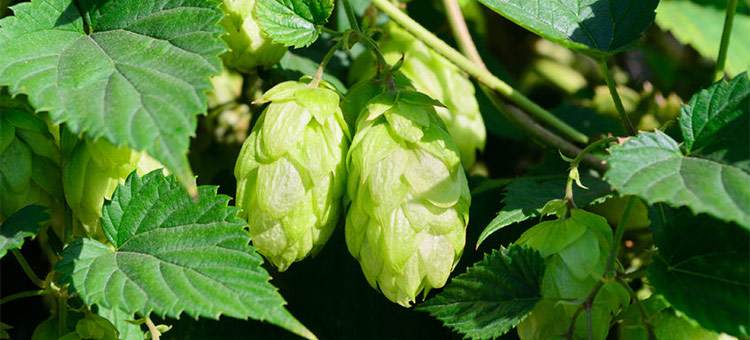Hops Essential Oil
Humulus lupulus

Description
Most commonly known for its use in crafting beers, "hops" as they're commonly called, are the female flowers (cones) of Humulus lupulus, a climbing plant most commonly grown in Europe.

Aromatically, I find Hop Essential Oil to be a bit too bitter/sharp for my liking when used alone, but it is a wonderful aromatic when blending at low dilutions with other oils for either therapeutic or fragrance blending. I find that aromatically, it blends particularly well with most other categories of essential oils including the woods, florals, citrus, spice and herbaceous oils.
Emotionally, Hops Essential Oil is considered to be sedating and can be potentially helpful in instances of anxiety, stress and insomnia.
I am hearing more and more about its use in natural deodorants, particularly at very low dilutions. Within his Tisserand Institute Complete Skin Series course, Robert Tisserand suggests its use in a natural deodorant formulation at 0.2%.
Hops Essential Oil smells fresh and sweet with a somewhat sharp (bitter), earthy/herbaceous aroma.
Hops Essential Oil Benefits and Uses
- Sedative
- Anxiety
- Stress
- Nervousness
- Insomnia
- Neuralgia
- Bruising
- Menstrual Issues
Sources: Valerie Ann Worwood, The Complete Book of Essential Oils and Aromatherapy, 25th Anniversary Edition (Novato, CA: New World Library, 2016, 594. Jeanne Rose, 375 Essential Oils and Hydrosols (Berkeley, CA: Frog, Ltd, 1999), 90.]
Hops Oil is also used in fragrancing, perfumery and anti-bacterial/deodorant applications.
Botanical Name
Plant Family
Common Method of Extraction
Steam Distillation
Plant Part Typically Used
Flowers known as cones or strobiles
Color
Golden Yellow
Consistency
Medium
Perfumery Note
Middle
Strength of Initial Aroma
Medium
Aromatic Description
Major Constituents
- a-Caryophyllene
- B-Myrcene
- B-Caryophyllene
- gamma-Cadinene
- delta-Cadinene
- a-Muurolene
See Essential Oil Safety for a more complete list of typical constituents.
Source: R.A. Malizia, J.S. Molli, D.A. Cardell, et al. Essential Oil of Hop Cones *Mumulus lupulus L.) (Journal of Essential Oil Research 11, 1999), 13-15. Source cited in Robert Tisserand and Rodney Young, Essential Oil Safety (Second Edition. United Kingdom: Churchill Livingstone Elsevier, 2014), 305-306.
Hops Essential Oil Safety Information
Robert Tisserand and Rodney Young do not precaution against any specific hazards or contraindications within their safety summary. [Robert Tisserand and Rodney Young, Essential Oil Safety (Second Edition. United Kingdom: Churchill Livingstone Elsevier, 2014), 306.] Julia Lawless mentions that it should be avoided by those with depression, however, she does not confirm why nor do I see this forewarning in other sources. [Julia Lawless, The Illustrated Encyclopedia of Essential Oils (Rockport, MA: Element Books, 1995), 149.]
Hops CO2 Supercritical Select and Total Extracts
In addition to being available as an essential oil, this botanical is available from a small number of reputable sources as a CO2 extract. CO2 extracts offer many advantages. However, they can have differing safety precautions than essential oils because the natural chemistry of CO2 extracts can differ from their essential oil counterparts. Not much safety information is documented from trusted sources for CO2 extracts. Use CO2 extracts with great care and do not assume that every CO2 extract has the same safety precautions as its essential oil counterpart.
General Safety Information
Do not take any oils internally and do not apply undiluted essential oils, absolutes, CO2s or other concentrated essences onto the skin without advanced essential oil knowledge or consultation from a qualified aromatherapy practitioner. For general dilution information, read AromaWeb's Guide to Diluting Essential Oils. If you are pregnant, epileptic, have liver damage, have cancer, or have any other medical problem, use oils only under the proper guidance of a qualified aromatherapy practitioner. Use extreme caution when using oils with children and be sure to first read the recommended dilution ratios for children. Consult a qualified aromatherapy practitioner before using oils with children, the elderly, if you have medical issues or are taking medications. Before using this or any essential oil, carefully read AromaWeb's Essential Oil Safety Information page. For in-depth information on oil safety issues, read Essential Oil Safety by Robert Tisserand and Rodney Young.
Shelf Life
Important Information About the Profiles
The essential oil information provided on AromaWeb is intended for basic educational purposes only. The references to safety information, test results, constituents and percentages is generalized information. Essential oils can vary greatly in composition. The data is not necessary complete and is not guaranteed to be accurate. The essential oil photos are intended to represent the typical and approximate color of each essential oil. However, essential oil composition and color can vary based on harvesting, distillation, age of the essential oil and other factors. Profiles for several CO2 Extracts and absolutes are included within the directory, and are denoted as such.
